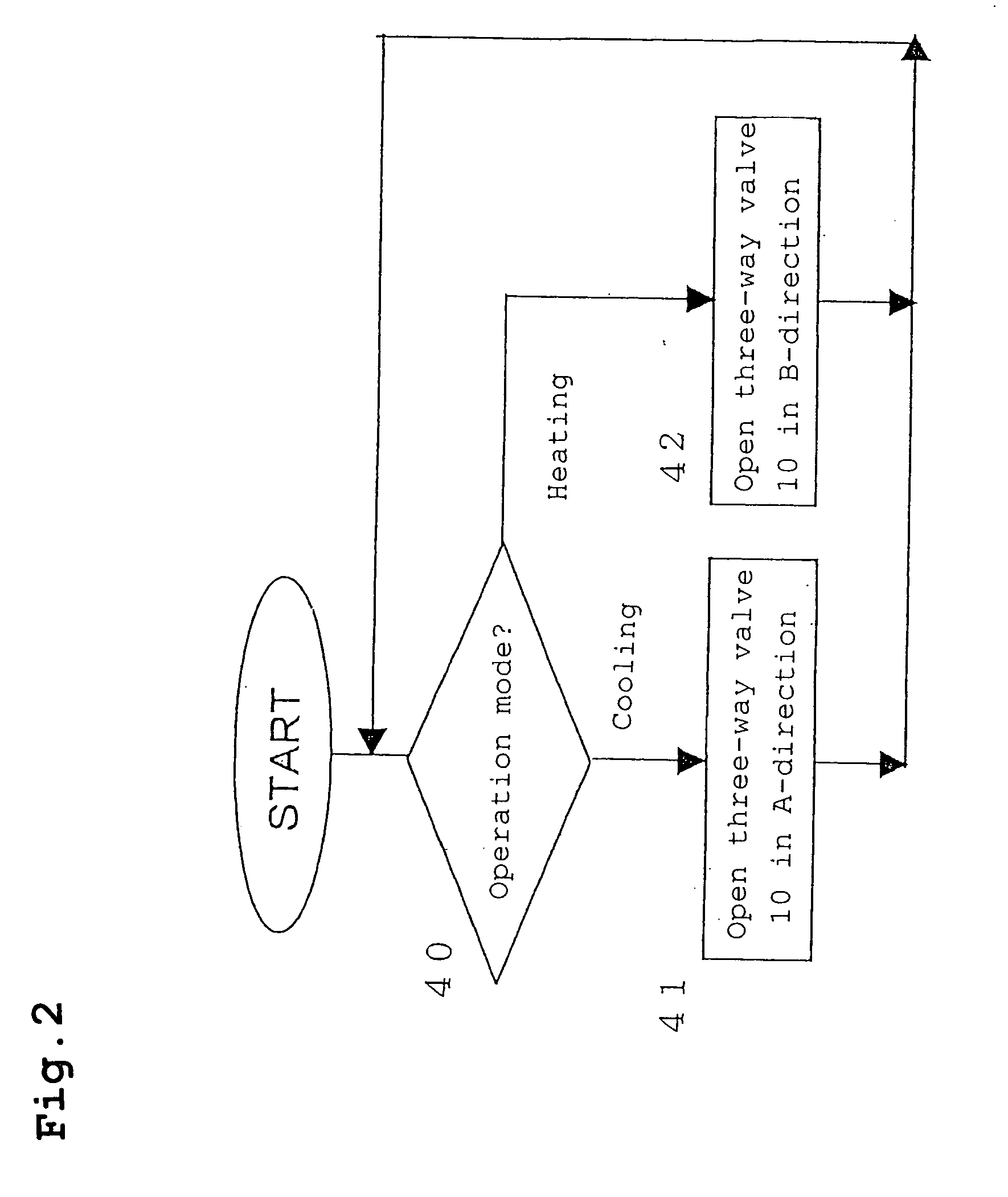Air conditioner
a technology for air conditioners and air conditioners, applied in the field of air conditioners, can solve the problems of increasing system complexity and cost, insufficient capacity of electric vehicle batteries, and insufficient heating capacity, and achieve the effects of preventing climate comfort from being degraded, reducing the reach time of target air-conditioning temperature, and saving spa
- Summary
- Abstract
- Description
- Claims
- Application Information
AI Technical Summary
Benefits of technology
Problems solved by technology
Method used
Image
Examples
embodiment 1
[0051]FIG. 1 is a block diagram of an air conditioner for vehicle according to an embodiment 1 of the present invention. An air conditioner for vehicle according to the embodiment 1 includes a refrigerant cycle 13, a cooling water cycle 14, and a blowing duct 1 for feeding temperature-conditioned air into a vehicle.
[0052] The refrigerant cycle 13 includes an evaporator 2 of performing air cooling by refrigerant evaporation in the blowing duct 1. A compressor 3 is installed to increase the pressure of the refrigerant evaporated by the evaporator 3. A refrigerant-to-water heat exchanger 4 is also installed to heat cooling water with the refrigerant discharged from the compressor 3. In addition, an expansion device 5 is mounted to decompress refrigerant discharged from the refrigerant-to-water heat exchanger 4 before it is fed into the evaporator 2.
[0053] The cooling water cycle 14 includes a heater core 6 installed on the downstream side of the evaporator 2 on the basis of the blast...
embodiment 2
[0067] The basic configuration of an air conditioner for vehicle according to an embodiment 2 of the present invention is the same as that of the embodiment 1 and is explained with a focus placed on differences between them. The same constituent elements as for the embodiment 1 have the same numbers on them.
[0068]FIG. 3 is a block diagram of an air conditioner for vehicle according to the embodiment 2 of the present invention.
[0069] The configuration of the refrigerant cycle 26 is the same as for the embodiment 1 and an explanation is thus omitted. The cooling cycle 27 is different from that of the embodiment 1 and does not include the three-way valve 10, the bypass 11 or the control means 12. A three-way valve 20 is installed between the power engine 9 and the pump 8. There is provided a bypass 22 connected with the three-way valve 20 as one end and a section between the power engine outlet water temperature means 21 and the refrigerant-to-water heat exchanger 4 as the other end....
embodiment 3
[0081] The basic configuration of an air conditioner for vehicle according to an embodiment 3 of the present invention is the same as that of the embodiment 2 and is explained with a focus placed on differences between them. The same constituent elements as for the embodiment 2 have the same numbers on them.
[0082]FIG. 5 is a block diagram of an air conditioner for vehicle according to the embodiment 3 of the present invention.
[0083] The refrigerant cycle 36 includes the evaporator 2 and the compressor 3 like the embodiment 2. In the embodiment 3, the first refrigerant-to-water heat exchanger 30 and the second refrigerant-to-water heat exchanger 32, and the first expansion device 31 installed between the two refrigerant-to-water heat exchangers 30, 32 are installed in place of the refrigerant heat exchanger 4 in the embodiment 2. The expansion device 12 in the embodiment 2 is corresponding to a second expansion device 33 in the embodiment 3.
[0084] Between the second expansion devi...
PUM
 Login to View More
Login to View More Abstract
Description
Claims
Application Information
 Login to View More
Login to View More - R&D
- Intellectual Property
- Life Sciences
- Materials
- Tech Scout
- Unparalleled Data Quality
- Higher Quality Content
- 60% Fewer Hallucinations
Browse by: Latest US Patents, China's latest patents, Technical Efficacy Thesaurus, Application Domain, Technology Topic, Popular Technical Reports.
© 2025 PatSnap. All rights reserved.Legal|Privacy policy|Modern Slavery Act Transparency Statement|Sitemap|About US| Contact US: help@patsnap.com



